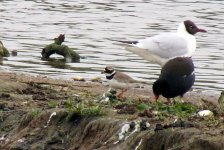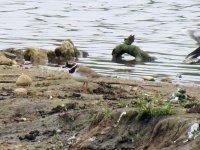Monday 27th May - morning
SAILING POOL
16 Mallard, 4 Canada Geese, 2 GC Grebe, 3 Tufted Duck, 5 Coot + 1 brood of 3 young.
FLASHES
15 Canada Geese, 2 Mute Swan, 7 Shelduck, 5 Coot, 14 Tufted Duck, 17 Mallard, 1 Gadwall (male), 5 LBB Gull, 4 Oystercatcher (third pair now sitting), 6 LR Plover, 2 Lapwing, 27 adult Avocet + 7 broods totalling 21 young
27 is a new peak count of Avocet for the reserve although I understand John and Terry first achieved this figure yesterday. The Avocet broods were as follows (starting in front of the hide and working anti-clockwise):-
4 : 3 (latest brood off the second Flash island; adult still incubating the final egg) : 2 (lost one overnight) : 3 : 4 : 3 : 2.
MOORS POOL
2 Mute Swan + 5 cgynets, 27 Canada Geese, Ross's Goose, 1 Shelduck, 1 Grey Heron, 3 Cormorant, 24 Mallard, 27 Tufted Duck, 41 Coot, 1 Little Grebe (Broadmeadow - no sign of any young), 8 GC Grebe + 4 young in Amy's Marsh (no sign of northern chick), 1 Gadwall (male), 1 Ringed Plover on east island (tundrae), 2 Lapwing (1 still sitting in Amy's Marsh; no sign of any young on the Broadmeadow but an adult was hanging around the telegraph pole on the southern boundary.....), 3 Oystercatcher (1 chick on domed island and remainder of clutch still being brooded; family party from the Broadmeadow hidden on the promontory), Garden Warbler, Cetti's Warbler, 150-200 Swift, 2 Common Tern, Arctic Tern, 250+ BH Gull (many hawking insects over the water)








